I previously posted on both single and double bed pleats. In light of the recent thread on mesh, I am sharing some of the information on pleats created using lace transfers, working out gauges for knitting predictable size fabric using them, and published in the Brother techniques book
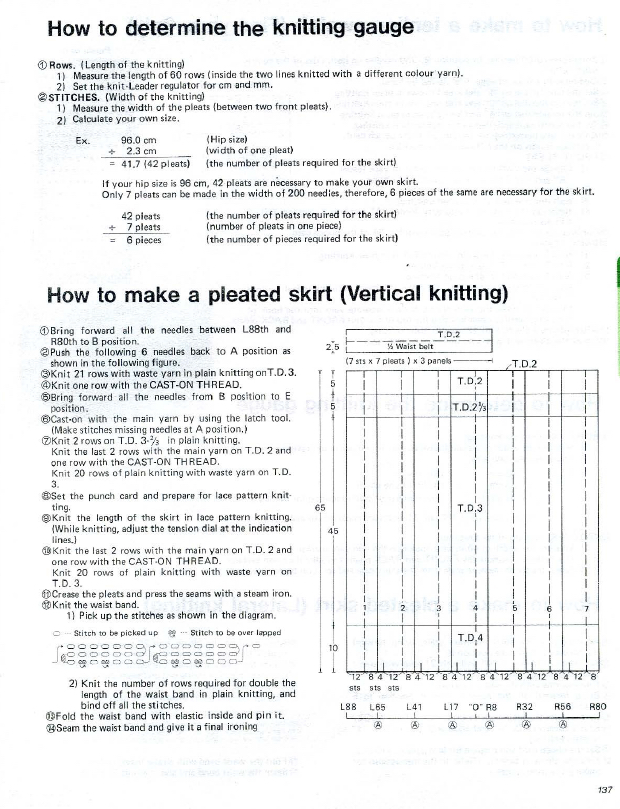

Category: Pleats
Pleats: ribbed , folding fabrics
RIBBED, FOLDING PLEATS result from varying the needle arrangement on both beds, usually in every needle rib. As with any knit fabric, the knit piece will fold toward the purl side along the length of the piece, not away from it. The bend can be put permanently into the fabric by leaving one or more consecutive needles on the same bed out of work. The non-working needle(s) will create a narrow vertical column of stocking stitch on the opposite bed which will roll itself toward its purl surface. By spacing the groups of non-working needles alternately between the beds, the fabric will immediately fold into pleats when taken off the machine. The same principle could be applied to hand knitting. The symbols: black dots indicate needles out of work, purple arrows the direction of the fold in the resulting fabric, and the needles in work on either bed, or any machine.
Sharp angles occur when there are enough needles in work on both beds to allow the fabric to fold over itself crisply before it is forced by the next group of out-of-work needles to fold once again in the opposite direction
 alternating direction of folds to create sharp or knife pleats
alternating direction of folds to create sharp or knife pleats
repeat the above configuration across the needle bed, going as narrow or as wide as desired, the series of pleats will face in one direction. Crystal pleats are very fine knife pleats often seen in sewing tuxedo shirts
double sharp or box pleats are a variation where the direction of every other pleat is reversed, extra stitch groups may be added between pleats to vary their spacing. The pleats are folded away from each other on the outside of the garment. Inverted box pleats are the same as a box pleat, but face inside the garment
added stitch group represented by a star, stitch count varied to suit
fold up as
accordion sharp pleats out of work needles evenly staggered on both beds
fold up as
Putting out-of-work needles on one bed close to out-of-work needles on the other will not allow the fabric to fold over completely before reversing direction, and will result in rounded or rolled, rather than sharp pleats. There should be one full needle rib stitch between needles out of work, highlighted below in red. Repeating the same selection results in rolled single pleats
fold up as

double rolled pleats mirror needle groups
fold up as![]()
in accordion rolled OOW needles are spaced evenly on both beds
Types of pleats, their width, spacing, and mixing with stretches of every needle rib, may be used in whole garments or garment details ie cuffs, peplums, single-fold large pleats in skirts and jackets, etc.
Brother Ribber Techniques Book page 37 illustration
Some considerations:
Normal shaping procedures are not practical in these fabrics. Tension changes are used from loose to tight to achieve shaping from wider at the bottom to narrower at the top, requiring extended swatches. The larger the finished items, such as skirts, produce more predictable results if the test swatch is a large one. A minimum of 100 rows for gauging is recommended. A test segment is made for each tension change. Swatches should be allowed to rest after being treated like the finished garment will be: blocked, pressed, washed, etc., then hung vertically and allowed to rest. After deciding the length, 2-4 inches need to be subtracted from the desired measurement to allow for the “drop” that is likely in the finished piece over time.
The fabric may look a bit different on one side than the other, either works as the exterior of the piece and is a matter of preference.
These are knits where the clicks between numbers on tension dials on machines come into use. In addition to the usual gauge calculations for knitting garments, a bit more math is needed.
The number of needles used needs to be divisible by the number of stitches used for any pleat.
Joining on inner folds rather than outer ones produces better results. Having an extra stitch at joining edges, with seaming using half a stitch on each side, will keep pleat widths constant.
The larger the pleat, the more bulk is created. Most skirts will require 3 panels with one seam worn on the center back. Yokes may be added to decrease bulk rather than having pleats meet at the waistline.
Ribbers on Japanese machines tend to knit tighter than main beds. At times an increase of 2 tension numbers may be required to get stitch sizes created by both beds to approach being equal. The other factor to consider is that the wider the plain knit vertical portion of the pleats, for stitches to knit off properly, the more tension needs to approach the # used to knit the same yarn in stocking stitch on the respective single bed. Tolerance varies between machines.
Experimentation is needed even before knitting the large swatches. It pays to be familiar with both your ribber and your yarn before trying these fabrics and to keep good notes.
Folded / true pleats occur when the groups of NOOW (needles out of work) that make the fold lines are spaced far enough apart so that the underlap of the pleat is quite wide. Rolled/ mock pleats occur when the groups of NOOW that form the fold lines are fairly close together. Stockinette/rib combinations: vertical columns of stocking stitches are created, sometimes combined with ribbed ones. The fabric lies flat and does not fold.
Double jacquard is usually an every-needle rib fabric, so pleats can be created in conjunction with it, even planned to occur within specific areas of the design repeat. Consider yarn weight and backing technique in planning for drape.
A series of needle arrangements to try, including one worked on every other needle, which requires the pitch change from P to H. Charts were created as combined tables using Mac Numbers 5/2018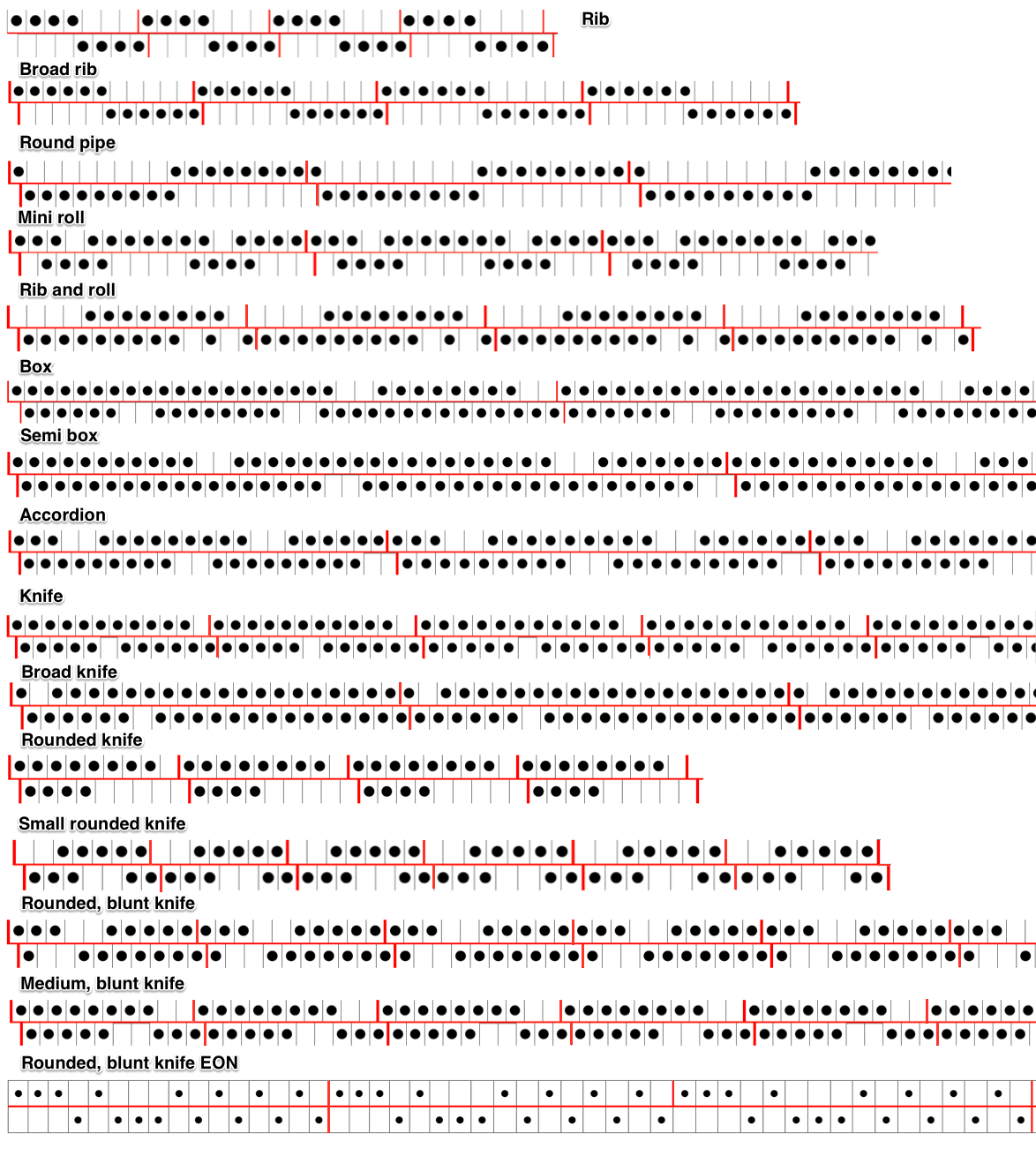
More from the Brother Ribber Techniques Book pp 108-112




Review of terms often used: full pitch = the needles of one bed are exactly opposite the needles of the other bed. Passap = racking handle up. Half pitch = the needles of one bed are directly opposite the gate pegs of the opposite bed. Passap = racking handle down. FNR: full needle rib = within the working area all needles on both beds are in working position, with the beds set at half-pitch. 1X1 rib set up= within the work area every other needle on both beds is in work in alternating positions, ribber set to full pitch. Tubular cast-on is often used for fabrics of this type, in both FNR and 1X1 rib setups.
“True” pleats have three components: the face, the fold-over or turn back, and the underside; they are formed by folding a piece of knitted fabric over. “Mock pleats” are produced by varying stitch patterns. Sometimes the terms S and Z are used in reference to how the pleat folds, with S pleats pointing the right and Z pointing to the left. The fold-over bulk is something that needs to be planned or even compensated for when creating garments ie such as skirts, where yokes are often added to minimize bulk at the waist and hips.
Studio tips and techniques #36, by Terry Burns, is now available for free download online and begins to cover Double bed pleated skirts tt-36-double_bed_skirts
Pleats: automating “pleating”, single bed
This post was originally written in 2013. I found myself reviewing it in 2018, and editing it with the intent to attempt a pleat sample using the Ayab interface. In those days I was using Intwined for some of my charts. The program has since been unsupported for Mac, without upgrades and a series of problems that led to my switching over to excel completely for my charts, and now to Numbers in the latest Mac OS.
I work primarily on multiple model Brother machines, in this instance the 910. Some of the information provided below may need tweaking for use in other brands KMs. “Automation” of some holding functions may be achieved using slip setting to knit required stitches. Below is the mylar sheet repeat used for my sample swatches. The setup is on working needles 21L, 19R, program for color reverse and twice the height; KCII (cancel end needle selection); first-row needle selection from left to right, and with carriage ending on the right the first set of needles selected will be those that knit, the remaining bed will slip. This is opposite to the configuration familiar in holding, where needles out to E are held, those in B or D will knit (Brother needle position jumped the letter C, they are A, B, D, E). In this type of knitting, all needles in use on the bed should be cleared with each pass of the carriage.
I have gotten used to keeping programming numbers for locations on mylar around a square to correspond to the lights surrounding the house icon on the 910 and worked with the following 2 options for my test swatches
In the samples below the first set of every other stitch/ black square in the increasing/decreasing angles were slipped on the non-selected needles to create/mark the inner purl fold, the second set in the area that does straight knitting tucked on non-selected needles to create/mark the knit outer fold. For the latter to occur, the cam buttons need to be switched to tuck <-> for 2 rows, and then back to slip <-> for the remaining knit repeat. Small holes are created at edges of slipped areas as miters are created, as would appear were the fabric created through holding.
A: the alternate fold areas as they appear on the machine during knitting
the fabric after some casual steaming shown on the knit side, the pleating just about doubling on itself
B: with the added knit rows, the swatch before steaming
here is the purl side after some steaming showing the change in overlap
its knit side
both fabrics allowed to “hang”
The look may be varied considerably by changing the sequencing of the number of knit stitches, and the number of plain knit rows between the EON slipped or tucked ones. Electronics facilitate that, and with machines capable of accepting programming of the whole needle bed, there is even greater freedom. The sample above was knit loosely in acrylic, the holes would be less apparent in a tighter knit. If bothersome, they may in theory be “avoided” by factoring in “wrapping” if every row of the repeat is drawn rather than every other. With only 60 squares available on the mylar it is possible to go twice as wide and produce fabric width that may suffice for a skirt’s length. With software that allows for programming the width of the needle bed, possibilities expand even more. When going double wide with a repeat such as the one above, some problems result not so much in the inner fold slipped rows, but in the outer fold of the tuck ones. As in nearly any knitting when needles have 2 side by side loops resting on them, these loops will create a float/ ladder, so the tuck rows will essentially behave like the slipped ones as the double loops are dropped rather than anchored on the subsequent pass of the carriage. In the configuration here if the double-wide button is used, one way to solve that issue would be to bring consistently the same of either of the 2 non selected needles out to D or E position (still faster than hand-selecting repeats by hand for holding), resulting in knit stitches and single tuck loops.
5/18/18 Working out the kinks: the same repeat is redrawn to factor in the reduction of the eyelets at edges of slipped areas: a partial graph showing “automatic wrap”. However, the “wrap” will fail with color reverse, and that first row would have only one stitch knitting. If double wide is used, then the wrap will happen around 2 needles, creating yet another “float”.
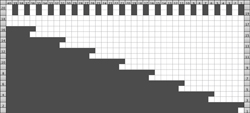 its color reverse
its color reverse 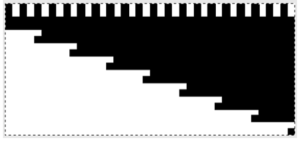
Plain knit rows (blanks on mylar) may be added at the bottom or top of the repeat to change pleat depth. Here is an amended repeat, discarding the “automatic wrap” idea, first prior to color reverse, then after
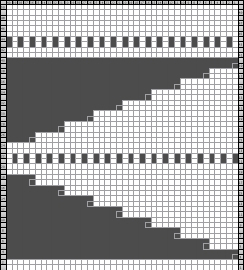
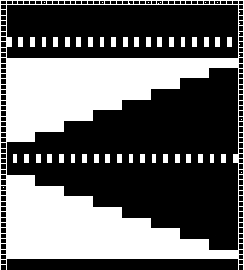 Those all blank rows would result in no stitches being knit, essentially a 2 row “free” carriage pass, and are removed. The repeat is now also capable of being knit twice as wide if desired, adding the hand technique on tuck folds
Those all blank rows would result in no stitches being knit, essentially a 2 row “free” carriage pass, and are removed. The repeat is now also capable of being knit twice as wide if desired, adding the hand technique on tuck folds
Below the edited repeat begins design using one pixel per stitch and per row. “Automatic” wrap happens as one row is knit, while the next preselects an extra needle. The yarn travels under the extra needle prior to its being knit on the next pass from the opposite side. There will still be an eyelet, a bit larger than hand wrapping, but smaller than without any wrap at all. The EON pixels in the center of the shape are tucked. For that to happen the knit carriage needs to have the cam buttons switched from slip to tuck, and back to slip after the 2-row sequence. The fabric folds out to the knit side. The EON (every other needle) set at the top of the shape is knit in the slip stitch setting, resulting in the fabric folding into the purl side. The process could be reversed to have each fold to the opposite side of the knit.
The carriage needs to be on the opposite side of increases in the number of stitches worked. Here the first preselection row should be from left to right, with carriage traveling to and from the right for the subsequent pairs of rows.
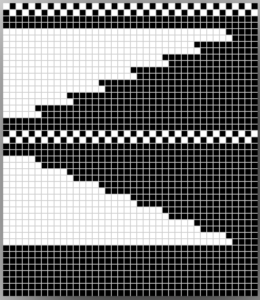
More variations: the slip stitch configuration below is changed to the same EON selection for 2 rows. The same could be done for the tuck fold. For this repeat, the first preselection row should be from right to the left, making that the side the knit carriage returns to after each pair of rows knit. The sample was knit in a too thin acrylic. Both eyelets and their “wraps are visible, as well as the direction of folds.
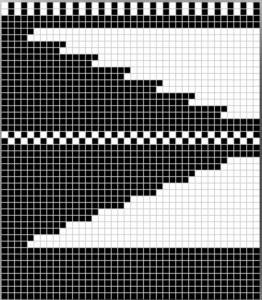

These are pleats in a skirt made eons ago, that have retained the fold over the course of many a year 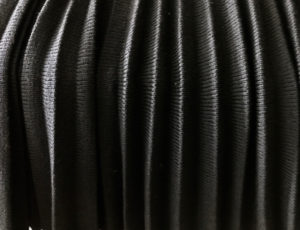
An added alternative for fold lines: create outside crease transferring EON to make a row of eyelets, create inside crease by knitting the desired row double row with 2 strands of garment yarn. “Automatic” repeat must be adjusted accordingly, whether by redrawing or punching, or using cam settings for the correct stitch formation.
Seaming should be planned on the inner fold of the fabric, depending on whether the purl or knit side is used as the “public” side, the least visible join being one that is grafted ie with Kitchener stitch.
The same principles may be applied to punchcard knitting but because the repeat size is 24 stitches the resulting fabric is one suitable for portions of garments/ accessories, in details such as ruffles and edgings. Punched holes would match the black squares in the color reversed repeats. “Air” knitting helps determine the exact needle location required, and to decide which side the first row must be selected prior to actual knitting. The image below shows the start of only one possible partial repeat based on the last one above
I usually sample my repeats by using hand selection and holding before committing to drawing on mylar or punching holes. An even number of rows is required in this technique.
On two needles
This is my present HK project, another scarf. Stitch pattern blocks are broken up by rows of solid knit and solid purl alternately, giving the fabric a slightly “pleated” effect, different from the usual square block configurations. The yarn is 60% silk, 40% wool as the last lace HK, all wool would probably have a crisper wave effect. A trial cotton swatch flattened out almost completely.

I am able to get good edges on my HKs, tend to never use the method suggested by some of slipping the first stitch, knitting it only on alternate rows. Such an edging could be added if preferred.
the chart below is the working repeat
My intent is to end the scarf with a partial repeat followed by bind off as seen below
…
New collars
In anticipation of participating in the Lowell show, and in the upcoming art to wear show at Cambridge Artists Cooperative in the fall, I have returned to fabricating wire collars. In writing updated artist statements I am again considering why fiber, certainly why wire. I continue to enjoy the surprise and problems in each new piece. Curiosity, exploring and experimentation temper the repetition of production.
Monofilament, fishing lines, wire, have a mind and personality of their own at the opposite pole of friendly yarn such as standard gauge wool. Attempting to work with them and their in-betweens makes the playground that much larger.
One present collar using both wire and vinyl:
the “knit”, convex side out
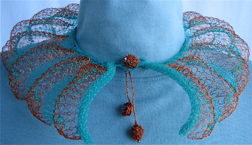
the”purl”, concave reverse side
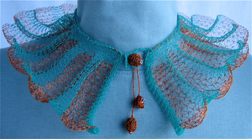 The oval “beads” consist wire crocheted over glass, the round one is coiled and stitched wire and beads.
The oval “beads” consist wire crocheted over glass, the round one is coiled and stitched wire and beads.
















